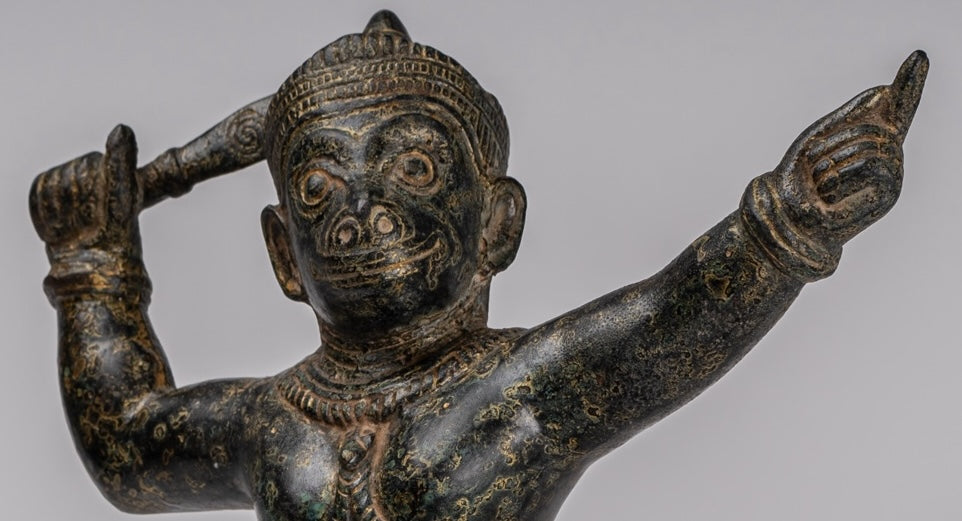-
Ganesha Statue - Antique Khmer Style Angkor Wat Bronze Seated Four Arm Ganesh Statue - 55cm/22"
Measures (Height) 55cm/22"
An antique Khmer style mounted bronze Ganesha torso in 12th century, Angkor Wat style. The distinctive patina of the piece is particularly delightful. Ganesha is the elephant headed son of Shiva. He holds a Pinda, Chakra, Sutra and Conch Shell or Shankha.
The Pinda that Ganesha holds is typically formed of rice or barley.
The Chakra are discus, a circular spinning weapon, often referred to as the Sudarshana Chakra, represents the cycle of time, the eternal nature of the universe, and the destructive power of divine justice.
The sutra that Ganesha holds refers to an aphorism - a memorable expression of a general truth or principle. Sutras are a genre of ancient ad medieval texts found in Hinduism, Buddhism and Jainism.
The Shankha symbolizes the primordial sound of creation, Om, from which the universe emerged. When blown, the conch produces a resonant sound that is believed to dispel negativity and create positive vibrations, signifying the creation and preservation of the cosmos. It also serves as a call to awaken spiritual seekers from their ignorance and guide them towards the path of righteousness.
The symbolism of Ganesha holding a conch shell goes beyond the visual aesthetics of religious iconography. It is a profound representation of purity, auspiciousness, divine sound, and the cosmic dance of creation. Ganesha, with the conch in hand, invites devotees to embark on a spiritual journey, overcome obstacles, and align their lives with the harmonious rhythms of the cosmos. In the intricate imagery of Lord Ganesha, the conch shell becomes a powerful emblem, resonating with the timeless wisdom and spiritual guidance that the deity offers to seekers on the path of self-discovery and divine realization.
This beautiful 4-arm bronze Ganesha has facial features and ornate jewellery typical of the Angkor Wat style. The cylindrical piling up of the hair into a high chignon and regimented hair curls demonstrate the ecumenical nature of iconography in the Angkor Wat period, the former associated with the supreme form of Vishnu, the latter with Shiva.
The direction of Ganesha's trunk has symbolic meaning. Here the trunk turns to Ganesha's left. This signifies the direction for success in the world. It is a position associated with grihastas, or householders.
Later he became widely revered as the Remover of Obstacles and more generally as Lord of Beginnings and Lord of Obstacles, patron of arts and sciences and the deity of intellect and wisdom.
To aid with safe shipping your Ganesha will be wood crated before shipping. There is no additional cost for this packing and shipping service.
One of the most recognizable of the Asian deities this representation of Ganesha is sure to enlighten your home with endlessly timeless style.
SATISFACTION GUARANTEE - We have been offering SE Asian Art for many years and are proud of the reputation we have developed for fair and honest listings. However, if for any reason, whatsoever, you are unhappy with your purchase please just let us know and we will provide a full refund. We want you to be 100% happy with your purchase.
-
The majority of orders will be shipped with DHL. This is a secure, express and fully tracked service.
Items less than 2Kg we typically ship using Royal Mail.
Once we receive your order we try to ship all orders the same or next working day.
Large and/or fragile pieces requiring palletising, specialist crating and/or extra packaging may take a little longer. Palletised shipments will be delivered curbside.
All orders over 35 GBP will be shipped free of charge.

-
We genuinely hope that all purchases delight.
However, if they do not, regardless of reason, we will refund all orders upon receipt of the unwanted item. Just notify us within 14 days of receiving your order that you wish to make a return and send the piece back to us with 30 days of delivery.
Let Us Help You Find The Piece You Desire
Let Us Help You Find The Piece You Desire
Buddha just received. Beautiful indeed.
François, Paris, France
The elephant arrived today—it is lovely!!! Thank you!
Christopher, Washington, DC, USA
I received Buddha today. It is perfect and has a home on my mantle. Love it!
Jennifer, Minneapolis, MN, USA


































































